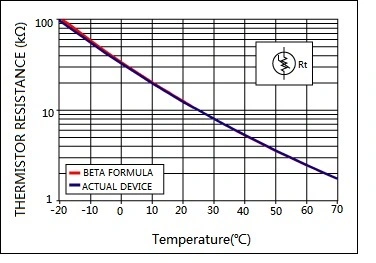
Thermistor B Value is a critical parameter for NTC thermistors, influencing their performance in various applications. Understanding the B Value Of Thermistor is key to achieving precise temperature measurements and selecting the right sensor for your application.In NTC thermistors, the NTC Thermistor B Value (β) defines the relationship between resistance and temperature. This parameter, often referred to as the NTC Thermistor Beta Value, is expressed in the following equation:

where:
Understanding and correctly calculating the Thermistor B Value ensures accurate temperature measurements, which is vital for applications where precision is critical.
These Negative Temperature Coefficient (NTC) thermistors, known for their high sensitivity and cost-effectiveness, are extensively used across industries.
The Thermistor B Value is a key material constant in NTC (Negative Temperature Coefficient) thermistors, defining their sensitivity to temperature changes. This NTC Thermistor Beta Value quantifies the relationship between temperature and resistance, where a higher value signals increased sensitivity, resulting in greater resistance changes for a given temperature shift.
A precise NTC Thermistor Beta Value is essential for accurate and linear temperature measurements. It impacts the thermistor’s overall performance, influencing the sensor’s accuracy, linearity, and suitable temperature range.
The NTC Thermistor Beta Value not only determines the sensitivity but also affects the stability of the resistance-temperature curve. A stable B Value across a broad temperature range enhances linearity and measurement accuracy.
Selecting the right NTC thermistor for any application depends on understanding the B Value. This includes knowing how to calculate it using methods like the two-point approach or the more precise Steinhart-Hart equation.
Variations in the NTC Thermistor Beta Value can significantly impact performance, especially in high-precision applications. Compensation techniques or individual calibration may be necessary to maintain accuracy across different temperature ranges.

The Thermistor B Value, or beta value, is crucial in determining temperature measurement accuracy. A higher NTC Thermistor Beta Value enhances sensitivity, allowing for more precise temperature readings.
The precision of mapping resistance to temperature relies heavily on the Thermistor B Value. Errors in the NTC Thermistor Beta Value can lead to significant inaccuracies, particularly in critical environments where precision is essential. Incorrect B Value may result in accurate readings at calibration points but diverge at other temperatures.
Understanding the NTC Thermistor Beta Value is vital for selecting the right NTC thermistor and ensuring accurate temperature monitoring across various applications.
The Thermistor B Value is a key parameter that influences the accuracy of temperature measurements. Understanding how to calculate the NTC Thermistor Beta Value is essential for ensuring precise sensor performance. Two primary methods are used for this purpose, each with varying levels of accuracy and complexity.
This simple method calculates the NTC Thermistors B Value using resistance measurements at two different temperatures:

Where:
This method is straightforward but assumes a constant NTC Thermistor Beta Value across the temperature range, which may lead to inaccuracies.
For higher accuracy, especially over a wide temperature range, the Steinhart-Hart equation is used:

Where:
This method requires three data points to determine the coefficients, resulting in a more accurate calculation of the NTC Thermistors Beta Value and a better representation of the thermistor’s behavior across different temperatures.
The Thermistor B Value is a critical factor when selecting the right thermistors for specific applications. Understanding the NTC Thermistor Beta Value is essential to match the sensor’s performance with the application’s needs.
The right NTC Thermistors Beta Value is crucial, especially in applications that operate over wide temperature ranges. High-precision applications like medical devices may prefer thermistors with well-characterized B Values, often relying on the Steinhart-Hart equation to minimize errors. Less critical applications may find the two-point method sufficient.
The NTC Thermistor Beta Value is not uniform across all temperatures, which can have significant implications:
Beta Value Variations and Their Impact:
Understanding the Thermistor B Value is essential for effective use of NTC thermistors in temperature measurement. The NTC Thermistor Beta Value affects accuracy, sensitivity, and linearity, making it crucial for selecting the right thermistor for specific applications.
The NTC Thermistor Beta Value determines how well a thermistor performs in various conditions. While the basic two-point method offers a quick β estimate, more precise methods like the Steinhart-Hart equation are needed for accurate readings over a wide temperature range. Careful selection of the NTC Thermistors Beta Value ensures optimal performance and accuracy in temperature measurements.
Awareness of calculation methods and beta value variations helps achieve precise temperature readings and enhances overall system performance. For high-precision applications, understanding and choosing the correct Thermistor B Value is vital for achieving reliable and accurate temperature measurement.
18927361658
AddB2006, Building 40, Shui'an Xindu, Xinsheng Community, Longgang Street, Longgang District, Shenzhen
E-mailinfo@dxmht.com
Copyright @ 2025 Thermistor,sensor,varistor leading manufacturer-DXMNo:84463
Copyright @ 2025 Thermistor,sensor,varistor leading manufacturer-DXM
Copyright @ 2025 Thermistor,sensor,varistor leading manufacturer-DXM